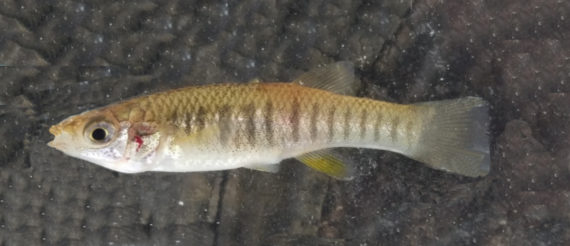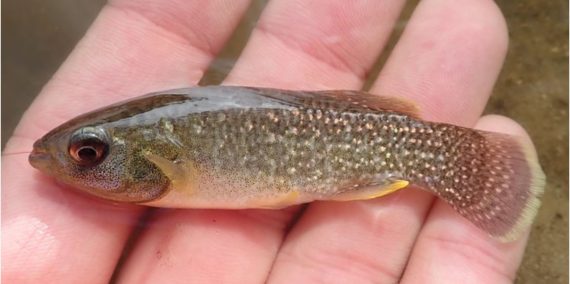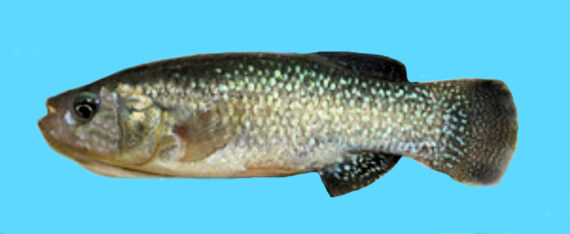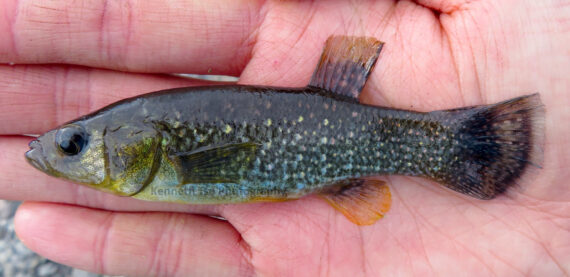Gulf Killifish, Fundulus grandis
 Gulf Killifish, Fundulus grandis, Juvenile. Fish caught from coastal waters off Punta Gorda, Florida, February 2017. Length: 5.1 cm (2.0 inches). Catch and photograph courtesy of George Brinkman, Guelph, Ontario, Canada. Identification courtesy of Dr. Martini Arostegui, Seattle, Washington.
Gulf Killifish, Fundulus grandis, Juvenile. Fish caught from coastal waters off Punta Gorda, Florida, February 2017. Length: 5.1 cm (2.0 inches). Catch and photograph courtesy of George Brinkman, Guelph, Ontario, Canada. Identification courtesy of Dr. Martini Arostegui, Seattle, Washington.
 Gulf Killifish, Fundulus grandis. Fish caught on Cedar Key, Florida, March 2018. Length: 7.5 cm (3.0 inches). Catch, photography and identification courtesy of Ben Cantrell, San Diego, California.
Gulf Killifish, Fundulus grandis. Fish caught on Cedar Key, Florida, March 2018. Length: 7.5 cm (3.0 inches). Catch, photography and identification courtesy of Ben Cantrell, San Diego, California.
 Gulf Killifish, Fundulus grandis. Fish caught on Cedar Key, Florida, October 2020. Length: 7.5 cm (3.0 inches). Catch, photograph and identification courtesy of Luke Ovgard, Klamath Falls, Oregon.
Gulf Killifish, Fundulus grandis. Fish caught on Cedar Key, Florida, October 2020. Length: 7.5 cm (3.0 inches). Catch, photograph and identification courtesy of Luke Ovgard, Klamath Falls, Oregon.
 Gulf Killifish, Fundulus grandis. Fish caught on Cedar Key, Florida, March 2018. Length: 8.9 cm (3.5 inches). Catch, photograph and identification courtesy of Eli (obsessiveangling.wordpress.com).
Gulf Killifish, Fundulus grandis. Fish caught on Cedar Key, Florida, March 2018. Length: 8.9 cm (3.5 inches). Catch, photograph and identification courtesy of Eli (obsessiveangling.wordpress.com).
 Gulf Killifish, Fundulus grandis. Fish caught from coastal waters off Cedar Key, Florida, December 2018. Length: 12.7 cm (5.0 inches). Catch, photograph, and identification courtesy of Kenneth Tse, Toronto, Canada.
Gulf Killifish, Fundulus grandis. Fish caught from coastal waters off Cedar Key, Florida, December 2018. Length: 12.7 cm (5.0 inches). Catch, photograph, and identification courtesy of Kenneth Tse, Toronto, Canada.
The Gulf Killifish, Fundulus grandis, and is known in Mexico as sardinilla del Pánuco. Globally, there are thirty-nine species in the genus Fundulus, of which five are found in Mexican waters, four in the Atlantic and one in the Pacific Ocean.
The Gulf Killifish have elongated, fusiform, compressed, and stout bodies with an elongated and deep caudal peduncle. Juveniles, females, and non-breeding males are generally drab brown without speckles; they are darker dorsally and transition to pale yellow ventrally with many small pale spots, mottling, or subtle bars. Breeding males are brilliantly colored and are deep blue dorsally with silver flecking; they have 12 to 19 stripes, blue pectoral and pelvic fins, light blue spots, yellow margins, and darkening on the underside of their head and gill plates. Some males have orange-red anal fins with red spots, yellow-orange pectoral and pelvic fins, and red spots on their pectoral fins. Their head is blunt and flattened with a short snout, a small upturned terminal mouth, and 5 pairs of sensory pores on the chin. Their anal fin has 9 to 12 rays and has a long base and is rounded; and, their single dorsal fin has 10 to 12 rays and is behind the anal fin. They have 9 to 12 gill rakers.
The Gulf Killifish are found in the top portion of the water column in estuaries, lowlands, uplands, coastal marshes, lagoons, rivers, and streams but the majority are found in brackish coastal waters. They are one of the largest killifish and reach a maximum of 18.0 cm (7.1 inches) in length with females being larger and more aggressive than males. They are highly adaptable and can withstand wide ranges of temperature changes (0oC (32oF) to 37oC (98oF)), dissolved oxygen content, and salinity. They form small feeding aggregations of 12 to 20 individuals, with their main food sources being small fish, aquatic insects, and vegetation. They are a key component of the food web in coastal marshes being preyed upon by fish, birds, and mammals. They also host parasites including several flatworms and roundworms that are consumed by various wading birds and marsh dwelling mammals, such as raccoons. Reproduction is oviparous with relatively low fecundity levels. During spring high tides, each female deposits annually on vegetation from 900 to 13,000 eggs in small batches. The eggs are then left to develop exposed to air. On the next high tide (usually 11 or 12 days later), the eggs are inundated then hatch and quickly become fully functional. They reach sexual maturity in three or four months and have a normal lifespan of one year.
The Gulf Killifish is a resident of Mexican waters of the Atlantic Ocean but has a limited distribution being found in coastal tidal pools and within the freshwater systems that drain into the Gulf of Mexico from Tuxpan, Veracruz, northward along the northwest coast of the Gulf of Mexico.
The juvenile Gulf Killifish can be confused with several topminnows and other killifish, however, it has a short blunt snout and a deep caudal peduncle. The Gulf Killifish is also the only killifish of the eight killifish found in the Gulf of Mexico that is longer than 7.6 cm (3.0 inches) and does not have bars on its sides.
From a conservation perspective the Gulf Killifish are currently considered to be of Least Concern with stable, widely distributed populations. They have been introduced for mosquito control to many areas along the northern coast of the Gulf of Mexico where they quickly became highly invasive dominating native species. There is currently an ongoing concerted effort to raise them via aquaculture in the State of Florida but these efforts have been hampered by low fecundity and a relatively low market price per fish. The Gulf Killifish are commonly used as bait fish by recreational and commercial fishermen targeting flounder, speckled trout, and red snapper. They are not used extensively by the aquarium trade as they are difficult to maintain. They are used for water quality testing including toxicity testing. They are of scientific interest as they have demonstrated an ability to adapt to high levels of pollution; they have become resistant to pesticides and oxidative stress and have a high metabolism suggesting an adaptation to anthropogenic contaminants in their environment. They are prone, however, to extreme changes in salinity, temperatures, depleted oxygen levels, and toxic events (such as massive oil spills). They played an important role in assessing the damage to the local marine environment caused by the Deepwater Horizon oil spill.